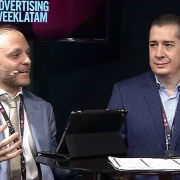What You Need to Know Today to Take Your Marketing Into the Future
 Programmatic has come a long way since its beginnings in 2007. Now that we’re more than 10 years in, data-driven marketing is transforming the way advertisers sell and buy media today. From what used to be considered ‘remnant’ inventory, programmatic now activates predictive audiences to power one-to-one conversations and closes the loop between measurement and optimization through powerful machine learning algorithms, in real-time. But despite our advancements in technology, our media ecosystem is still fragmented. Whether it’s a lack of integration across systems or services organized into siloes, we’re left with a patchwork of data and channels that are, collectively, a mess, 10 years later. In fact, 57 percent of marketers are stuck inside this patchwork and admit their marketing infrastructure is siloed by channel, not well-integrated or lacking entirely.
Programmatic has come a long way since its beginnings in 2007. Now that we’re more than 10 years in, data-driven marketing is transforming the way advertisers sell and buy media today. From what used to be considered ‘remnant’ inventory, programmatic now activates predictive audiences to power one-to-one conversations and closes the loop between measurement and optimization through powerful machine learning algorithms, in real-time. But despite our advancements in technology, our media ecosystem is still fragmented. Whether it’s a lack of integration across systems or services organized into siloes, we’re left with a patchwork of data and channels that are, collectively, a mess, 10 years later. In fact, 57 percent of marketers are stuck inside this patchwork and admit their marketing infrastructure is siloed by channel, not well-integrated or lacking entirely.
But here’s the good news…we can clean it up!
[blockquote author=”” pull=”normal”]LATAM alone will have 68 percent smartphone penetration by 2020, second only to APAC.[/blockquote]
The size of the LATAM programmatic market is growing progressively – LATAM alone will have 68 percent smartphone penetration by 2020, second only to APAC. As the market grows, how will the level of technological sophistication impact the industry in years to come?
Now more than ever, brands want and need greater control of their media supply. More consumers are blocking ads than ever; 3 in 10 consumers will block ads in 2018. Ads have often been placed next to offensive media, showing up on content that doesn’t align with the brand’s core values. In a vast and convoluted media ecosystem, marketers have struggled to have full transparency from both partners and agencies–and, subsequently, to deliver a better brand experience.
[blockquote author=”” pull=”pullright”]3 in 10 consumers will block ads in 2018[/blockquote]
How do we solve for this? It starts with measuring marketing goals the right way. Ten years ago we would define customers with simple proxy metrics, like clicks. But this doesn’t get you to your true business outcome and can spur issues like fraud because…bots can click! If it’s a marketer’s goal to get more clicks, it often leads to cheaper clicks. And if there’s a need for more volume of cheap clicks, it’s more likely ads will be placed next to offensive media and essentially undermine brands. So while you’re pushing down quality to be able to afford reach, what you’re really getting is fraudulent clicks from a bunch of bots. Transformation is a process but if marketers have the capabilities to access the very best media placements at scale, they’ll be able to optimize spend and move away from clicks to an ROI metric that proves actual value for the business.
In addition, marketers need to understand that the average consumer is on four or more devices on any given day. An omnichannel demand-side platform integrated with a demand-side platform with an identity management layer underneath is the most effective way to create customer-centric marketing across every channel. Adopting technology that will consolidate all media marketing onto a single platform and, as a result, give consumers a more consistent, personalized message from their favorite brands across their desktop, mobile or iPad while will drive better consumer experiences and better marketer outcomes.
Looking into the future, artificial intelligence (AI) will be one of the next major technological advances that will impact the consumer experience. With AI, companies can learn from their interactions with customers and use that data to supply consumers with even more relevant advertising. And, unstructured data like mood and weather can be used to add more variables to the bidding process. In addition, AI-driven ad creatives will be the next-generation version of dynamic creative optimization to deliver things like interactive ad units. Using AI to further optimize digital ad spending is the next step marketers are taking to make ads less intrusive and more customer-centric as we head into the next 10 years of programmatic.
Eventually, anything that’s addressable will be touched or influenced through programmatic technologies. We’re at a point where we can optimize across display, mobile, social, and, in 10 years’ time or less, drones, wearables, VR, AR and IoT will be added to the mix. But before that happens, we need the right goals, technology and data to get us there.
The future is indeed, now.
Contact us: http://www.mediamath.com/es-latam/





Trackbacks & Pingbacks
[…] post What You Need to Know Today to Take Your Marketing Into the Future appeared first on […]
Leave a Reply
Want to join the discussion?Feel free to contribute!